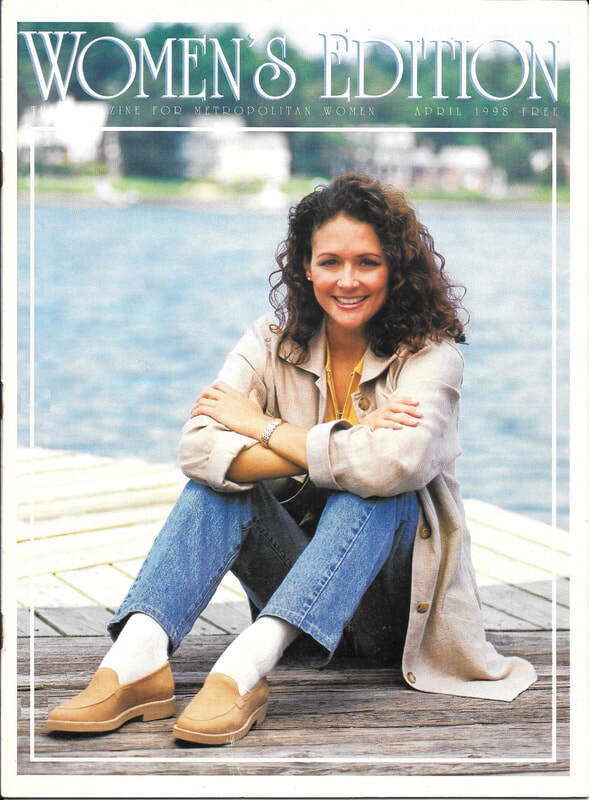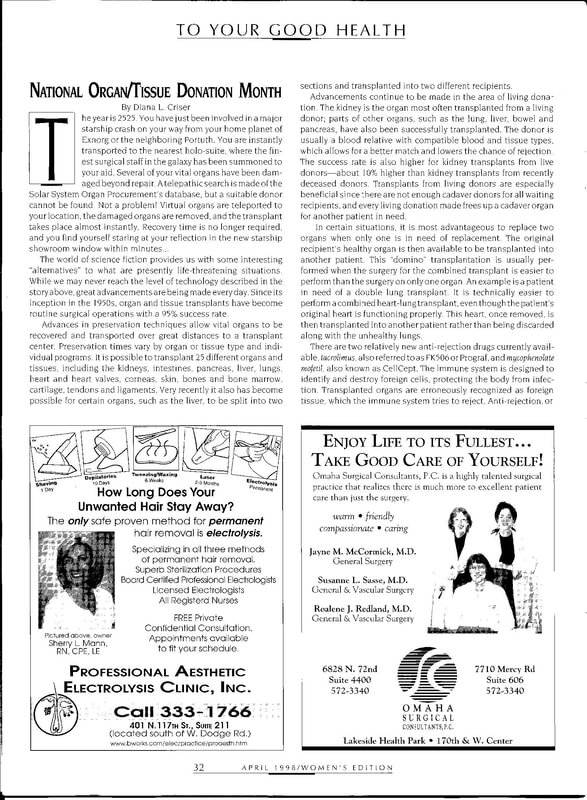To Your Good Health - April 1998
NATIONAL ORGAN/TISSUE DONATION MONTH
By Diana L. Criser

he year is 2525. You have just been involved in a major starship crash on your way from your home planet of Exnorg or the neighboring Portuth. You are instantly transported to the nearest holo-suite, where the finest surgical staff in the galaxy has been summoned to your aid. Several of your vital organs have been damaged beyond repair. A telepathic search is made of the Solar System Organ Procurement's database, but a suitable donor cannot be found. Not a problem! Virtual organs are teleported to your location, the damaged organs are removed, and the transplant takes place almost instantly. Recovery time is no longer required, and you find yourself staring at your reflection in the new starship showroom window within minutes.
The world of science fiction provides us with some interesting "alternatives" to what are presently life-threatening situations. While we may never reach the level of technology described in the story above, great advancements are being made every day. Since its inception in the 1950s, organ and tissue transplants have become routine surgical operations with a 95% success rate.
Advances in preservation techniques allow vital organs to be recovered and transported over great distances to a transplant center. Preservation times vary by organ or tissue type and individual programs. It is possible to transplant 25 different organs and tissues, including the kidneys, intestines, pancreas, liver, lungs, heart and heart valves, corneas, skin, bones and bone marrow, cartilage, tendons and ligaments. Very recently it also has become possible for certain organs, such as the liver, to be split into two sections and transplanted into two different recipients.
Advancements continue to be made in the area of living donation. The kidney is the organ most often transplanted from a living donor; parts of other organs, such as the lung, liver, bowel and pancreas have also been successfully transplanted. The donor is usually a blood relative with compatible blood and tissue types, which allows for a better match and lowers the chance of rejection. The success rate is also higher for kidney transplants from live donors - about 10% higher than kidney transplants from recently deceased donors. Transplants from living donors are especially beneficial since there are not enough cadaver donors for all waiting recipients, and every living donation made frees up a cadaver organ for another patient in need.
In certain situations, it is most advantageous to replace two organs when only one is in need of replacement. The original recipient's healthy organ is then available to be transplanted into another patient. This "domino " transplantation is usually performed when the surgery for the combined transplant is easier to perform than the surgery on only one organ. An example is a patient in need of a double lung transplant. It is technically easier to perform a combined heart-lung transplant, even though the patient's original heart is functioning properly. This heart, once removed, is then transplanted into another patient rather than being discarded along with the unhealthy lungs.
There are two relatively new anti-rejection drugs currently available, tacrolimus, also referred to as FK506 or Prograf, and mycophenolate mofetil, also known as CellCept. The immune system is designed to identify and destroy foreign cells, protecting the body from infection. Transplanted organs are erroneously recognized as foreign tissue, which the immune system tries to reject. Anti-rejection, or immunosuppressive drugs, are taken to reverse or prevent this occurrence. Dosages must be carefully monitored and lowered when possible, to prevent negative reactions with other medications and to decrease side effects, while still preventing rejection. An increased risk of infection is a side effect of all anti-rejection drugs, since their main function is to suppress the immune system.
Regardless of the donor's age, there is always something which can be donated, either for transplant or research. A person under the age of 19 can become a donor with parental consent, and a senior citizen's heart, which may not meet normal transplant criteria, can be transplanted temporarily in time-sensitive situations until a more suitable heart becomes available.
The process of becoming an organ or tissue donor basically boils down to one simple step - inform your family of your desire to become an organ or tissue donor upon your death. A federal law established in 1986 requires hospitals to give the family members of the deceased the opportunity to donate their loved one's organs. Unfortunately, out of those families who are asked, over half say no.
In addition to informing your family members, to ensure your wishes are known, carry a Uniform Donor Card, and document your desire to become an organ or tissue donor in a Living Will. Even though these are both legal documents, organs and tissues are never removed without the consent of the family, regardless of the documented wishes of the deceased. Remember this simple statement: "If you haven't told your family you're a donor, you're not."
Becoming an organ or tissue donor is easy; there is no national registration process and no expense to the donor's family. Organ donation is supported by most of the world's major religions as a selfless gift of love, and an open casket funeral can still be held with no physical indication that organ or tissue donation has occurred.
Unfortunately, less than half of the people who die each year and meet the criteria for acceptable organ donation actually become organ donors. Those who have donated were allowed the opportunity to provide the gift of a full life to someone else who may not have gotten the chance otherwise. Someday that "someone else" may be you or one of your loved ones. Since "virtual organs" are not yet available to us, it is up to each of us individually to make a decision on organ and tissue donation, and to discuss the decision with our family members. Do it today!
The world of science fiction provides us with some interesting "alternatives" to what are presently life-threatening situations. While we may never reach the level of technology described in the story above, great advancements are being made every day. Since its inception in the 1950s, organ and tissue transplants have become routine surgical operations with a 95% success rate.
Advances in preservation techniques allow vital organs to be recovered and transported over great distances to a transplant center. Preservation times vary by organ or tissue type and individual programs. It is possible to transplant 25 different organs and tissues, including the kidneys, intestines, pancreas, liver, lungs, heart and heart valves, corneas, skin, bones and bone marrow, cartilage, tendons and ligaments. Very recently it also has become possible for certain organs, such as the liver, to be split into two sections and transplanted into two different recipients.
Advancements continue to be made in the area of living donation. The kidney is the organ most often transplanted from a living donor; parts of other organs, such as the lung, liver, bowel and pancreas have also been successfully transplanted. The donor is usually a blood relative with compatible blood and tissue types, which allows for a better match and lowers the chance of rejection. The success rate is also higher for kidney transplants from live donors - about 10% higher than kidney transplants from recently deceased donors. Transplants from living donors are especially beneficial since there are not enough cadaver donors for all waiting recipients, and every living donation made frees up a cadaver organ for another patient in need.
In certain situations, it is most advantageous to replace two organs when only one is in need of replacement. The original recipient's healthy organ is then available to be transplanted into another patient. This "domino " transplantation is usually performed when the surgery for the combined transplant is easier to perform than the surgery on only one organ. An example is a patient in need of a double lung transplant. It is technically easier to perform a combined heart-lung transplant, even though the patient's original heart is functioning properly. This heart, once removed, is then transplanted into another patient rather than being discarded along with the unhealthy lungs.
There are two relatively new anti-rejection drugs currently available, tacrolimus, also referred to as FK506 or Prograf, and mycophenolate mofetil, also known as CellCept. The immune system is designed to identify and destroy foreign cells, protecting the body from infection. Transplanted organs are erroneously recognized as foreign tissue, which the immune system tries to reject. Anti-rejection, or immunosuppressive drugs, are taken to reverse or prevent this occurrence. Dosages must be carefully monitored and lowered when possible, to prevent negative reactions with other medications and to decrease side effects, while still preventing rejection. An increased risk of infection is a side effect of all anti-rejection drugs, since their main function is to suppress the immune system.
Regardless of the donor's age, there is always something which can be donated, either for transplant or research. A person under the age of 19 can become a donor with parental consent, and a senior citizen's heart, which may not meet normal transplant criteria, can be transplanted temporarily in time-sensitive situations until a more suitable heart becomes available.
The process of becoming an organ or tissue donor basically boils down to one simple step - inform your family of your desire to become an organ or tissue donor upon your death. A federal law established in 1986 requires hospitals to give the family members of the deceased the opportunity to donate their loved one's organs. Unfortunately, out of those families who are asked, over half say no.
In addition to informing your family members, to ensure your wishes are known, carry a Uniform Donor Card, and document your desire to become an organ or tissue donor in a Living Will. Even though these are both legal documents, organs and tissues are never removed without the consent of the family, regardless of the documented wishes of the deceased. Remember this simple statement: "If you haven't told your family you're a donor, you're not."
Becoming an organ or tissue donor is easy; there is no national registration process and no expense to the donor's family. Organ donation is supported by most of the world's major religions as a selfless gift of love, and an open casket funeral can still be held with no physical indication that organ or tissue donation has occurred.
Unfortunately, less than half of the people who die each year and meet the criteria for acceptable organ donation actually become organ donors. Those who have donated were allowed the opportunity to provide the gift of a full life to someone else who may not have gotten the chance otherwise. Someday that "someone else" may be you or one of your loved ones. Since "virtual organs" are not yet available to us, it is up to each of us individually to make a decision on organ and tissue donation, and to discuss the decision with our family members. Do it today!
DROP ME A LINE
Like what you see? Let's get in touch!
Diana Criser, CUA, CXA
User Experience Practitioner
Omaha, Nebraska
User Experience Practitioner
Omaha, Nebraska
402.598.4969


